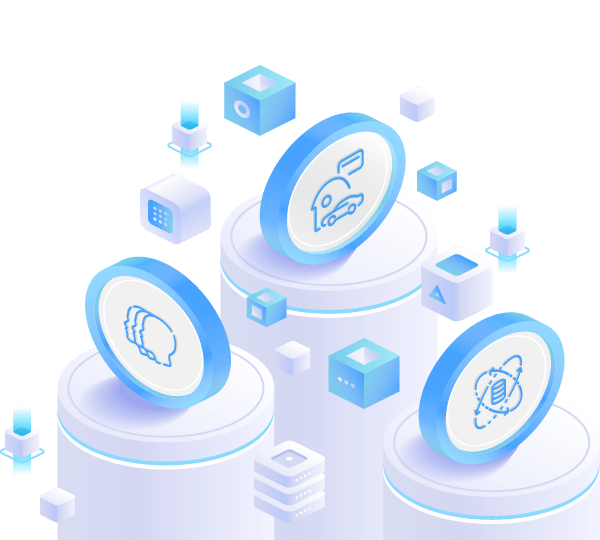Fitur Inti dan Tokenomik Ontologi
Bagian ini menelusuri fitur inovatif yang membedakan Ontology, termasuk kerangka identitas terdesentralisasi (ONT ID), Kerangka Pertukaran Data Terdistribusi (DDXF), dan mekanisme konsensus VBFT berkecepatan tinggi. Ini juga mengeksplorasi sistem dual-token Ontology, di mana ONT digunakan untuk tata kelola dan ONG menggerakkan operasi on-chain, menjelaskan peran dan manfaat mereka dalam ekosistem.
Fitur Utama Ontology

Ontologi menonjol dalam lanskap blockchain karena pendekatannya yang inovatif dalam menyelesaikan tantangan kritis terkait kepercayaan, privasi, dan keamanan data. Serangkaian fitur-fiturnya dirancang dengan cermat untuk memenuhi kebutuhan individu maupun perusahaan, menjadikannya platform yang serbaguna untuk berbagai aplikasi. Pada intinya, Ontologi berfokus pada desentralisasi, kinerja tinggi, dan solusi berbasis pengguna, memastikan pengguna dapat berinteraksi secara mulus dengan sistem digital sambil tetap mengontrol data dan identitas mereka.
kerangka identitas terdesentralisasi
Salah satu fitur paling menonjol dari Ontology adalah kerangka identitas terdesentralisasi, ONT ID. Sistem ini memungkinkan individu dan organisasi untuk membuat, mengelola, dan memverifikasi identitas digital mereka tanpa bergantung pada entitas terpusat. ONT ID memberdayakan pengguna dengan memberi mereka kepemilikan penuh dan kontrol atas informasi pribadi mereka, yang dapat secara selektif dibagikan atau diverifikasi bila diperlukan. Fitur ini sangat berharga dalam skenario yang memerlukan otentikasi, seperti mengakses layanan keuangan, catatan kesehatan, atau sistem pemerintah, sambil memastikan bahwa privasi pengguna tetap utuh.

Kerangka Pertukaran Data Terdistribusi (DDXF)

Fitur kunci lain dari Ontologi adalah Kerangka Pertukaran Data Terdistribusi (DDXF)-nya, yang memfasilitasi berbagi data yang aman, transparan, dan efisien. DDXF menyediakan mekanisme terdesentralisasi di mana pemilik data dapat mempertahankan kontrol atas data mereka sambil memungkinkan pihak yang diotorisasi untuk mengakses dan memanfaatkannya. Kerangka kerja ini sangat penting dalam industri seperti perawatan kesehatan, di mana data sensitif perlu dibagikan di antara beberapa pemangku kepentingan sambil mematuhi standar privasi dan regulasi yang ketat. Dengan memanfaatkan teknologi blockchain, DDXF memastikan bahwa pertukaran data dapat diaudit dan tahan terhadap penyusup, memupuk kepercayaan di antara para peserta.

Mekanisme konsensus VBFT
Dasar teknis Ontology didukung oleh mekanisme konsensus VBFT-nya, yang menggabungkan Verifiable Random Function (VRF), Byzantine Fault Tolerance (BFT), dan Proof of Stake (PoS). Model hibrida ini memberikan throughput transaksi tinggi dan latensi rendah, sehingga cocok untuk aplikasi yang membutuhkan kinerja cepat dan dapat diandalkan. Berbeda dengan mekanisme konsensus tradisional yang kesulitan dalam menyeimbangkan skalabilitas dan keamanan, VBFT memastikan bahwa Ontology dapat menangani volume transaksi yang besar sambil menjaga integritas jaringan. Fitur ini penting untuk aplikasi tingkat enterprise dan kasus penggunaan dunia nyata yang menuntut kinerja yang tangguh.
Interoperabilitas
Platform ini juga sangat menekankan pada interoperabilitas, mengakui bahwa masa depan blockchain terletak pada integrasi yang mulus dengan sistem-sistem yang sudah ada dan jaringan blockchain lainnya. Ontology mendukung beberapa mesin virtual, termasuk Mesin Virtual Ethereum (EVM), yang memungkinkan pengembang untuk mendeploy kontrak pintar yang kompatibel dengan Ethereum pada jaringan Ontology. Kompatibilitas ini memperluas daya tarik Ontology kepada sejumlah besar pengembang dan memastikan bahwa dApps dan alat yang sudah ada dapat beralih dengan mudah ke dalam ekosistemnya.
model token ganda
Fitur penting lainnya adalah model dual-token Ontology, yang mencakup token ONT dan ONG. ONT berfungsi sebagai token governance, memungkinkan pengguna untuk berpartisipasi dalam keputusan jaringan dan memberikan suara pada proposal kunci. Di sisi lain, ONG berfungsi sebagai token utilitas, digunakan untuk menutupi biaya transaksi dan menggerakkan operasi on-chain. Struktur ekonomi ini tidak hanya memastikan keberlanjutan jaringan tetapi juga menyelaraskan insentif bagi peserta, mendorong keterlibatan aktif dalam ekosistem.
Sistem Dual-Token
Sistem token ganda Ontology adalah tiang penopang kerangka ekonominya, dirancang untuk memastikan keberlanjutan jaringan dan fungsionalitasnya. Berbeda dengan banyak platform blockchain yang beroperasi dengan satu token untuk semua tujuan, Ontology menggunakan dua token yang berbeda—ONT dan ONG—untuk memisahkan tata kelola dari utilitas. Desain ini memperkenalkan tingkat fleksibilitas dan efisiensi yang kritis untuk menjaga ekosistem yang sehat dan dapat diskalakan.
token ONT
Persediaan Maksimum:1 miliar token ONT
Token ONT berfungsi sebagai token tata kelola jaringan Ontology. Ini memberikan pemegang hak untuk berpartisipasi dalam proses pengambilan keputusan yang membentuk masa depan platform. Dengan memegang ONT, pengguna dapat memberikan suara pada proposal tata kelola kunci, seperti upgrade protokol, perubahan parameter konsensus, dan pengembangan jaringan kritis lainnya.
Pendekatan partisipatif ini memastikan bahwa Ontology tetap menjadi platform yang didorong oleh komunitas di mana pemangku kepentingan memiliki hak langsung dalam arahannya. Selain itu, peran tata kelola ONT sejalan dengan etos terdesentralisasi platform, memperkuat pentingnya pengambilan keputusan kolektif dalam lingkungan tanpa kepercayaan.
Pembagian Distribusi Token ONT
- Insentif Komunitas & Mitra (12%)
- Pengembangan Ekosistem (25%)
- Komunitas Teknis (10%)
- Mitra Institusi & Investor (28%)
- Tim Ontologi (15%)
- NEO Dewan & Airdrops (10%)
token ONG
Token ONG, di sisi lain, adalah token utilitas dari jaringan Ontology. Ini digunakan terutama untuk menggerakkan operasi on-chain, seperti biaya transaksi, eksekusi kontrak pintar, dan pemeliharaan jaringan. ONG dihasilkan melalui mekanisme staking, di mana pemegang ONT menerima imbalan ONG dari waktu ke waktu.
Struktur dual-token ini menciptakan model ekonomi yang mandiri, karena pemegang ONT termotivasi untuk mendukung jaringan dengan melakukan staking token mereka dan mendapatkan ONG sebagai imbalannya. Distribusi ONG memastikan bahwa jaringan memiliki pasokan sumber daya yang berkelanjutan untuk menutupi biaya operasional tanpa bergantung pada pendanaan eksternal.
Jadwal Pemberian dan Rencana Pembebasan
Ontology menerapkan jadwal pelucutan untuk mitra institusional dan investor untuk memastikan komitmen jangka panjang. Para konstruktor institusional dan investor awal memiliki periode pelucutan dua tahun, dengan sebagian token menjadi tersedia setiap enam bulan.





